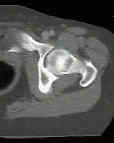- Discussion

- see adult femoral anteversion
- w/ flouroscopy obtain a true lateral view of proximal femur in which femoral neck & shaft are parallel but offset about 1 cm;
- measure the angle referenced from the horizontal;
- from the true lateral view, one can adjust rotation of the distal fragment in order to achieve femoral neck anteversion of 15 to
20 deg (or achieve 15-20 deg of internal rotation of epicondylar axis relative to femoral neck);
- hence, whatever angle the flouroscope requires to superimposed the femoral neck and shaft, the epicondylar axis needs to be internally rotated 20 deg;
- finally, assess thigh foot angle of uninjured leg and attempt to match this rotation w/ the injured extremity;
- Reider Test:
- prominence of the greater trochanter indicates axis of the femoral neck
Clinical determination of femoral anteversion. A comparison with established techniques.
The anatomy and functional axes of the femur.
Femoral anteversion
Cephalomedullary screws as the standard proximal locking screws for nailing femoral shaft fractures.
Getting the Rotation Right: Techniques for Assessing Rotation in Intramedullary Tibial and Femoral Nailing
Use of Inherent Anteversion of an Intramedullary Nail to Avoid Malrotation in Femur Fractures
Original Text by Clifford R. Wheeless, III, MD.
Last updated by Clifford R. Wheeless, III, MD on Thursday, November 28, 2013 6:24 pm

